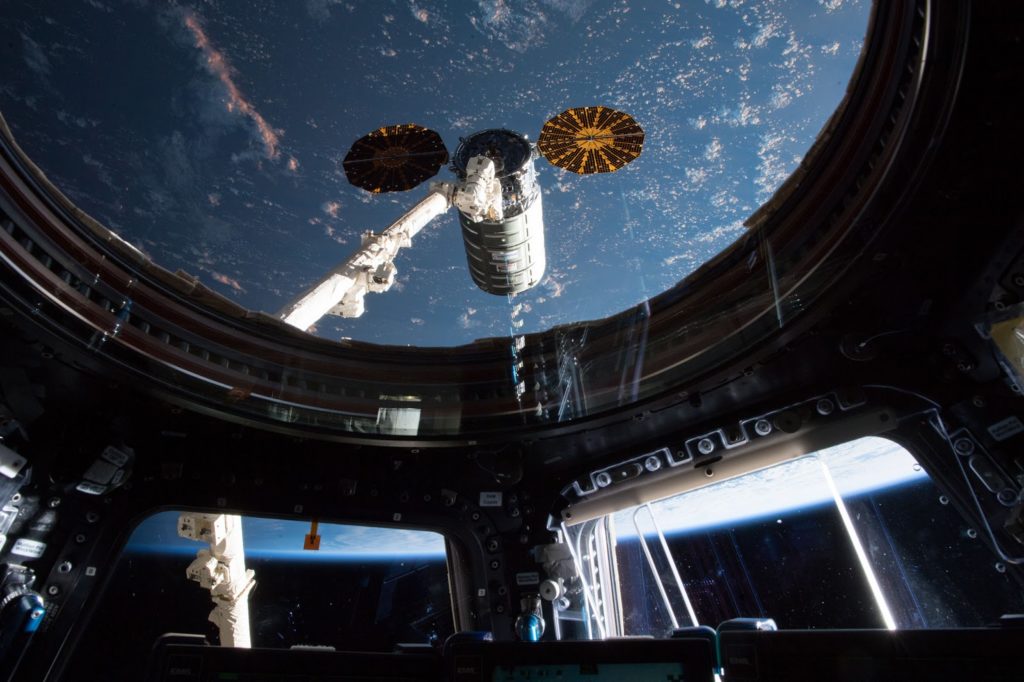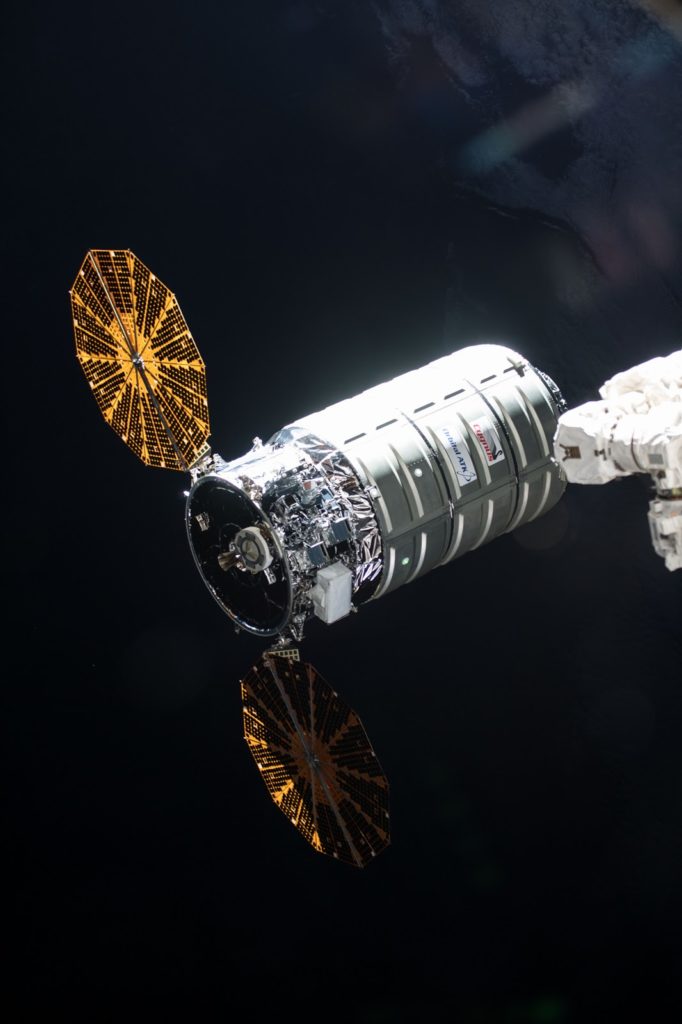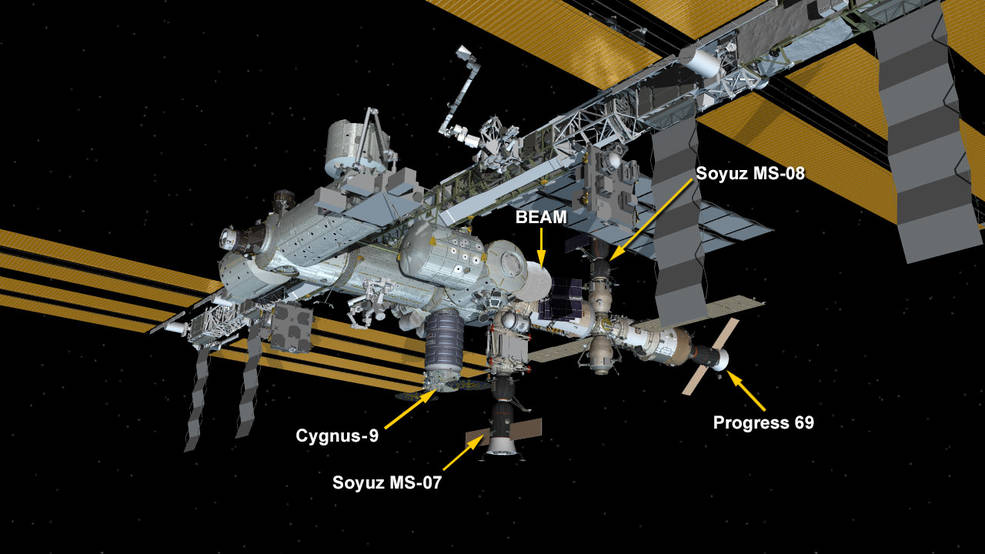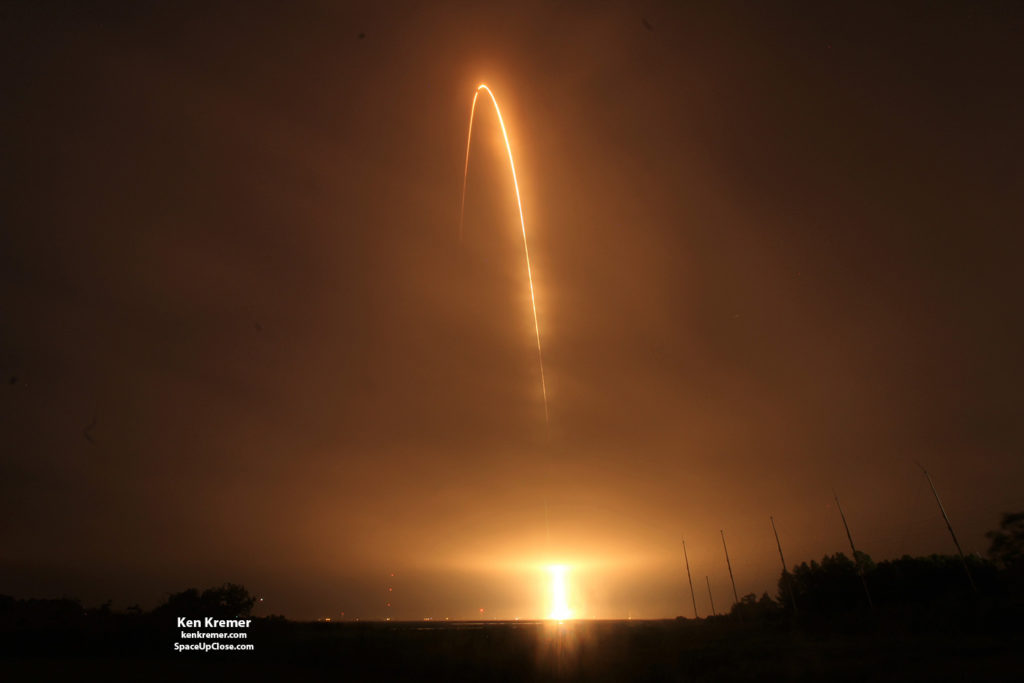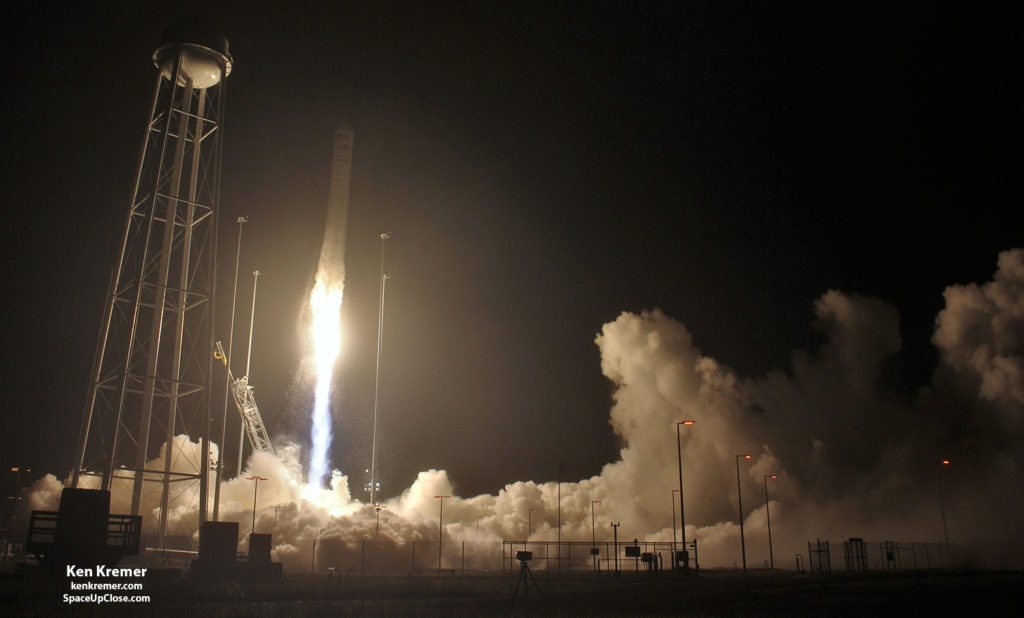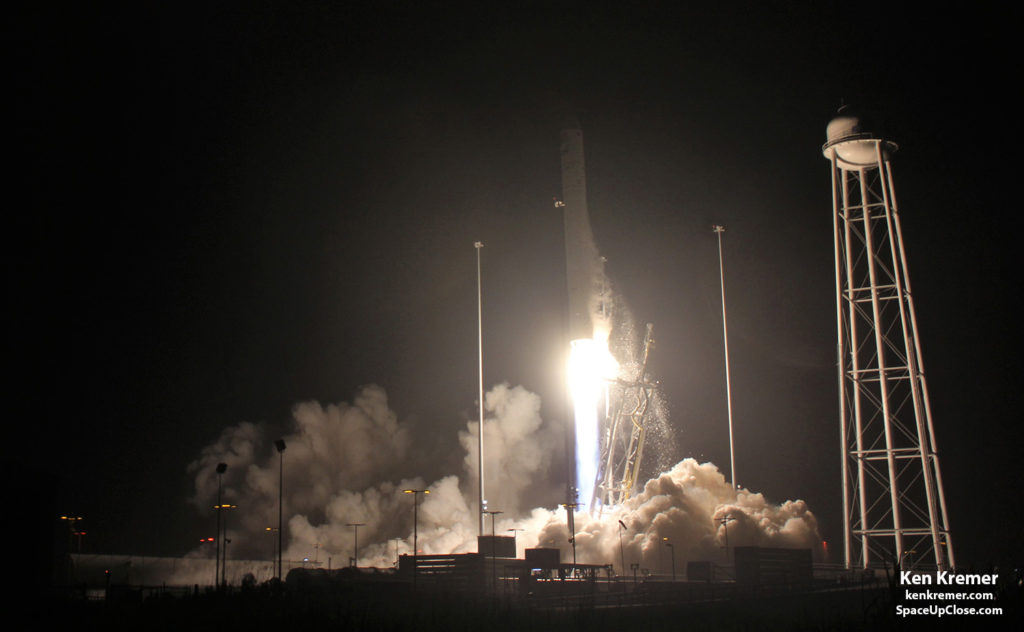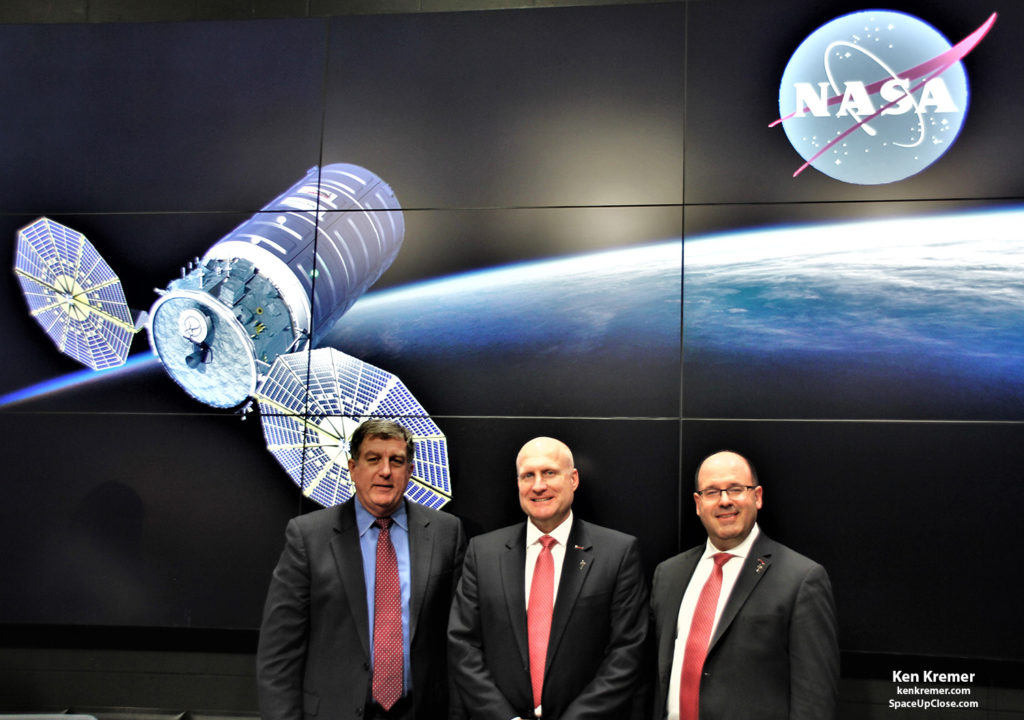predawn launch from NASA’s Wallops Flight Facility on the Virginia shore on
Monday, May 21, and a three day orbital chase, an Orbital ATK Cygnus cargo
freighter arrived at the International Space Station (ISS) early Thursday
morning, May 24, loaded with over 3 tons of critical cargo, cubesats and a host
of science experiments including the Cold Atom Laboratory.
NASA’s Jet Propulsion Laboratory will chill atoms to a colder temperature
than the vacuum of space.
choreographed series of thruster firings to raise its initial orbit and close
in on the million pound orbiting lab complex.
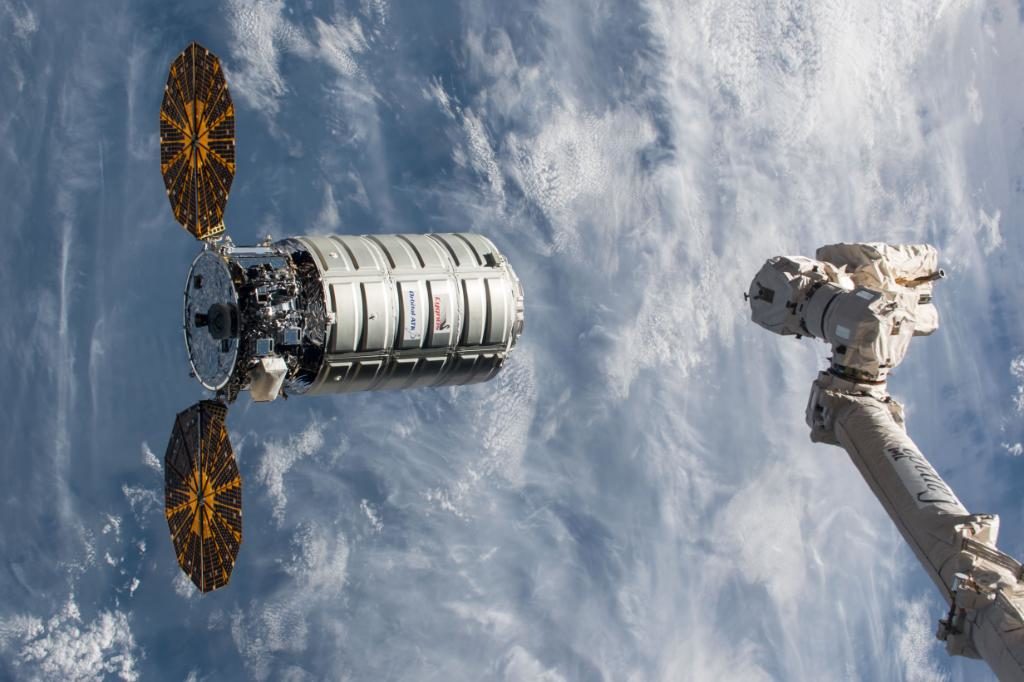 |
|
Orbital
ATK Cygnus OA-9 cargo vehicle is approaching the International Space Station to deliver ~7,385 pounds of cargo and scientific experiments. May 24, 2018. Credit: NASA |
burn that brought the vehicle to the Joint Targeting Reference Point (JTRP) some
4 km (2.5 miles) under the ISS.
firing Cygnus moved in progressively to a series of station keeping points between
1.5 km (0.9 mi) and then 250 m (820 ft), 30 m (98 ft), and finally 12 m (36 ft).
17.6 m (57.7 ft) long robotic arm to reach and capture Cygnus.
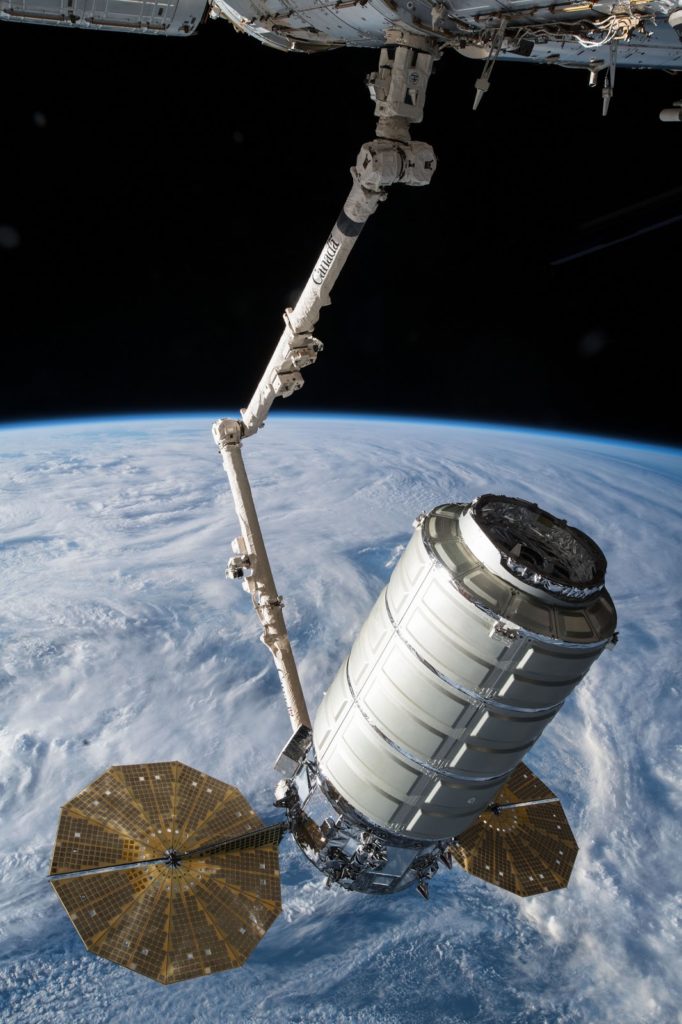 |
| The Orbital ATK Cygnus OA-9 space freighter is slowly maneuvered by the Canadarm2 robotic arm toward the Unity module for installation on the International Space Station on May 24, 2018 to resupply the Expedition 55 crew. Credit: NASA |
Expedition 55 Flight Engineer Scott
Tingle captured
the Cygnus cargo
spacecraft using the International Space Station’s Canadian-built robotic arm
at 5:26 a.m. EDT as the vehicles soared
some 425 k (264 miles) over the southern Indian Ocean.
Arnold while NASA astronaut and Drew Feustel Cygnus system during the entire procedure.
in Houston at NASA’s Johnson Space Center (JSC) then took over and positioned Cygnus for
installation to the orbiting laboratory’s Earth-facing port of the Unity
module.
a.m. EDT after Cygnus was bolted into place with 16 bolts – 4 gangs of 4 bolts
to complete the hard mate to the Space Station.
the South Pacific at the time of berthing.
all proceeded flawlessly since Monday’s nighttime blastoff.
Cygnus came to life and roared to orbit with a crackling thunder as it slowly
liftoff off pad 0A at 4:44 a.m. EDT May 21 from NASA’s Wallops Flight Facility in
Virginia and lit up the predawn nighttime sky with a stunningly beautiful
launch to orbit – darting in and out of low hanging clouds.
cargo freighter loaded with some 7400 pounds (3,350 kg) of critical NASA cargo
bound for the six person crew living and working aboard the International Space
Station (ISS).
Video Caption: Launch of
Orbital ATK Antares rocket on May 21, 2018 from NASA Wallops Flight Facility
oceanside pad 0A in Virginia carrying S.S. J.R. Thompson OA-9 resupply ship to
the ISS – as seen in this remote camera video taken at the pad. Credit: Ken
Kremer/kenkremer.com/spaceupclose.com
the orbiting outpost.
hatches between the station and Cygnus on Friday and begin methodically unloading
all the gear.
Cygnus will depart in mid-July after the crew reloads the vehicle with several
tons of unneeded trash.
It will then conduct about 2 weeks of orbital
operation including science and cube sat deployments before being programmed
for a final thruster firing that will set the vehicle on course for a fiery and
destructive reentry into the atmosphere and harmless breakup over unpopulated
areas of the Pacific Ocean.
alternatively named CRS-9 or OA-9, is Orbital ATK’s ninth contracted cargo
delivery flight to the International Space Station for NASA. 11 cargo flights
are planned altogether under the initial contract with NASA.
are 7,400 pounds (3,350 kg) of cargo including science experiments, research
gear, food, water, spare parts, crew supplies and vehicle hardware to support the Expedition 55
and 56 crews.
30,000 kilograms vital equipment, supplies and scientific equipment to the
space station as part of Orbital ATK’s Commercial Resupply Services-1 (CRS-1)
contract with NASA.
aboard includes:
hardware
investigations
equipment
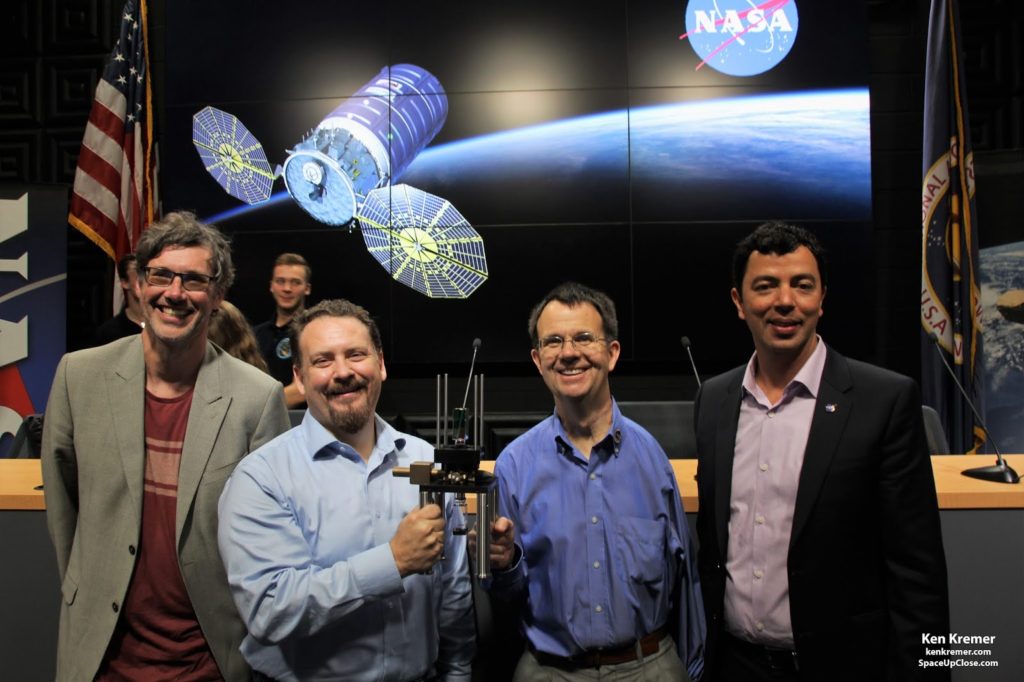 |
|
The Cold Atom Lab team including Nobel Prize Winner Eric
Cornwell hold full scale model of the experiment riding along on Cygnus to the ISS. Credit: Ken Kremer/kenkremer.com/SpaceUpClose.com |
The Biomolecule Extraction and Sequencing Technology (BEST),
an investigation to identify unknown microbial organisms on the space station
and understand how humans, plants and microbes adapt to living on the station
The Cold Atom Laboratory, a physics research
facility used by scientists to explore how atoms interact when they have almost
no motion due to extreme cold temperatures
A unique liquid separation system from Zaiput Flow Technologies that
relies on surface forces, rather than gravity, to extract one liquid from
another
The Ice Cubes Facility, the first commercial
European opportunity to conduct research in space, made possible through an
agreement with ESA (European Space Agency) and Space Applications Services.
The Microgravity Investigation of Cement Solidification
(MICS) experiment is to investigate and understand the complex
process of cement solidification in microgravity with the intent of improving
Earth-based cement and concrete processing and as the first steps toward making
and using concrete on extraterrestrial bodies.
Three Earth science
CubeSats
RainCube (Radar in a CubeSat) will be NASA’s
first active sensing instrument on a CubeSat that could enable future rainfall
profiling missions on low-cost, quick-turnaround platforms.
TEMPEST-D (Temporal Experiment for Storms and
Tropical Systems Demonstration) is mission to validate technology that could
improve our understanding of cloud processes.
CubeRRT (CubeSat Radiometer Radio Frequency
Interference Technology) will seek to demonstrate a new technology that can
identify and filter radio frequency interference, which is a growing problem
that negatively affects the data quality collected by radiometers, instruments
used in space for critical weather data and climate studies.
and new Expedition
56-57 crew
will launch from the Baikonur Cosmodrome on June 6 in the Russian Soyuz
MS-09 spacecraft for a six-month mission.
Watch for Ken’s continuing onsite coverage of Orbital ATK,
SpaceX, ULA, Boeing, Lockheed Martin and more space and mission reports direct from the Wallops
Flight Facility, Kennedy Space Center and Cape Canaveral Air Force Station,
Florida.
Earth and Planetary science and human spaceflight news: www.kenkremer.com –www.spaceupclose.com –
twitter @ken_kremer – ken
at kenkremer.com


